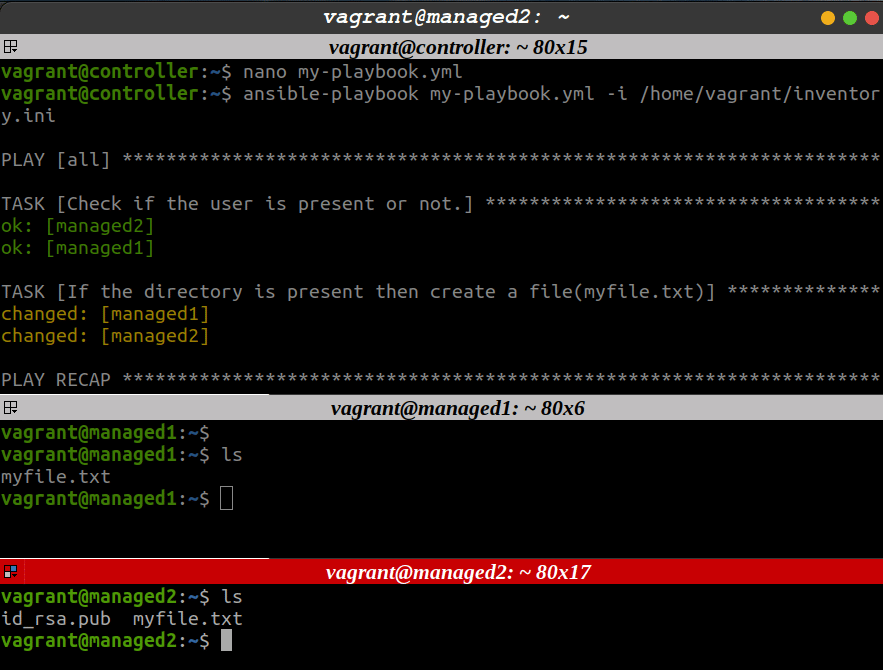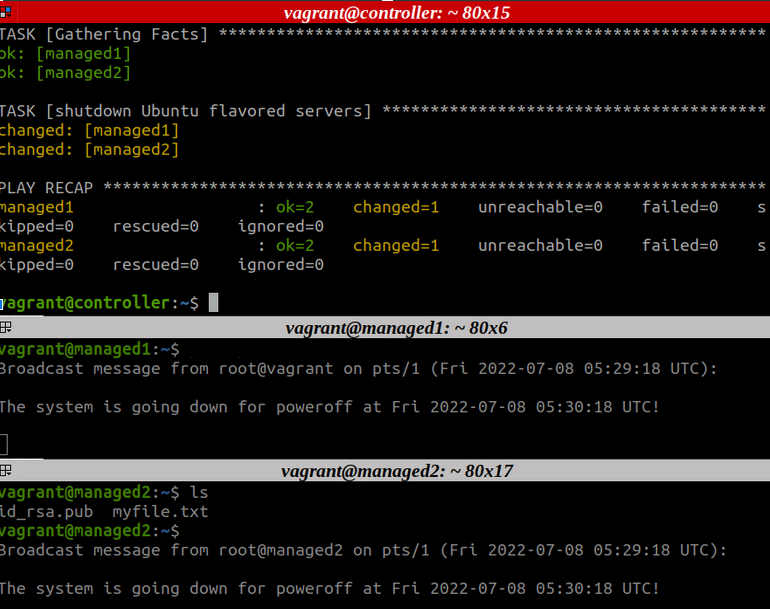“Ansible is a configuration management tool used for automating remote system management tasks like software deployment and installing updates, configuration management, orchestration, and many other IT tasks.”
In This Article
We will cover:
1. Purpose of the “When” statement.
2. How to use the “When” statement in different scenarios.
3. Present some working examples of using the “When” statement.
What Will You Need?
In this tutorial, we assume that:
1. You have installed Ansible on your system(Ubuntu 20.04 in our case).
2. You know what Ansible is used for and how to set up a basic local testing environment.
Experimental Setup
In this lab, we have an Ansible controller host with Ubuntu 20.04 system. There are two target nodes: one with the Ubuntu 20.04 system and another one with Debian Buster.
The When Clause in Ansible
Suppose you are working on a certain Ansible project, and at a certain point, you want to skip a specific step for a specific host. To understand it better, let’s take an example, suppose you want to skip installing some sort of package on a host if the required version of the software is not available. This is where the “When” clause comes in handy. This is pretty simple to use, as we will see it later.
1. A Simple Conditional With “when”
A basic conditional statement works with a single task. What you have to do is to create a task and then add a condition using the “when” statement. This “when” statement applies to a test or simply a condition for this task. Look at this example:
tasks: - name: Running shutdown command on CentOS-based systems ansible.builtin.command: /sbin/shutdown -t now when: ansible_facts['os_family'] == "CentOS"
When a task or playbook is executed, the tests are checked against all the hosts. If the test is passed for any host, Ansible will execute the task; otherwise, it will skip the execution. In the above example, the shutdown command will be executed for any system that matches the criteria of being a CentOS-based OS.
2. Using the “ansible_facts” With the “when” Conditional
A task can also be skipped based on facts. Facts are property of a host, such as IP of the host, type of operating system, etc. The following are some fact-based use cases:
1. Installing a package for a particular OS version.
2. Skipping firewall configuration on hosts with private IP addresses.
3. Shutting down system with specific OS family.
Multiple conditions for a “when” clause can also be merged. This uses logical operators like or not. An example is shown below:
tasks: - name: Shut off Debian 10 and Debian 11 systems ansible.builtin.command: /sbin/shutdown -t now when: (ansible_facts['distribution'] == "Debian" and ansible_facts['distribution_major_version'] == "10") or (ansible_facts['distribution'] == "Debian" and ansible_facts['distribution_major_version'] == "11")
As mentioned earlier, Ansible performs conditional evaluations on the targets(hosts) prior to running a task. In the task above, If the condition, i.e., the system is Debian 10 or Debian 11, is found to be true, Ansible will execute the requested shutdown task. If the condition is unmet, Ansible will simply skip this task.
If multiple tasks are required to be true simultaneously(a logical “and” condition), we can list them as:
tasks: - name: Shut off Ubuntu 17.04 systems ansible.builtin.command: /sbin/shutdown -t now when: - ansible_facts['distribution'] == "Ubuntu" - ansible_facts['distribution_major_version'] == "17.04"
3. Using the “registered variables” With “when” Conditional
In Ansible, registered variables can also be used with conditionals. These variables are obtained from the output of a task in a play and can be used as a base for further tasks.
Example:
- hosts: web_servers tasks: - name: Running a shell command and registering its outcome as a variable using the ‘register’ keyword. ansible.builtin.shell: /usr/bin/pwd register: var_object - name: Running a shell command based on the result of the last task ansible.builtin.shell: /usr/bin/ls when: var_object.stdout = =”ubuntu”
To see how the when clause works in Ansible, let’s take some working examples.
Example 1: Basic Usage
In this example, Ansible will check if a specific user exists on the remote host. If the user’s (myuser) directory is found, it will create a file(myfile.txt) inside this directory. First, create a playbook (my-playbook.yml) with the below content:
--- - hosts: all gather_facts: no become: true tasks: - name: Check if the user is present or not. stat: path: /home/vagrant register: myuser - name: If the directory is present, then create a file(myfile.txt) file: path: /home/vagrant/myfile.txt state: touch when: myuser.stat.exists
When this playbook is run, the output is as follows:

Example 2: Usage-based on ansible_facts
In this example, Ansible will gather facts about the OS family and shut off all the Ubuntu-based remote systems using the when statement.
--- - hosts: all gather_facts: yes become: true tasks: - name: shutdown Debian-based servers ansible.builtin.command: /sbin/shutdown -t now when: ansible_facts['os_family']=="Debian"

Conclusion
In this guide, we have seen how to use the “when” clause in Ansible. We have just seen a high-level overview of the “when” statement; you can further explore how to use the “when” conditional with loops, imports, and includes statements.


